Why are summer residents so attracted to black tomatoes?
Tomatoes are one of the most beloved and popular crops among gardeners. There is a wide variety of varieties that vary in shape and color. They grow red, yellow, orange and even black tomatoes.
Black fruits have this shade due to coloring substances (anthocyanin, carotenoid, chlorophyll). This variety of tomato is not very sensitive to changes in soil acidity, so it is easier to grow than other varieties.
Features of black tomatoes
The advantage of black tomatoes is their rich taste, since the pulp contains a large amount of sugar and organic acids, and a bright aroma.
The anthocyanin contained in these tomatoes has an antitumor effect on the human body, improves immunity, inhibits the aging process, and improves the functioning of the cardiovascular system.
Many other substances contained in this product have a positive effect on human health:
- Thanks to lycopene, the activity of the prostate gland in men is normalized.
- Provitamin A improves vision.
- The complex of useful substances helps to increase tone in the body and activates sexual function.
However, tomatoes can also have a negative effect on the body. Thus, it is not recommended to eat them for elderly people, as well as those suffering from osteoporosis and joint diseases.
Important! It is not the tomatoes themselves that are harmful, but the acids they contain. They can provoke spasm of the gallbladder in case of cholelithiasis.
Consuming this product in large quantities leads to the accumulation of calcium in the body and the deposition of salts. This causes the formation of kidney stones and contributes to the erosion of tooth enamel.
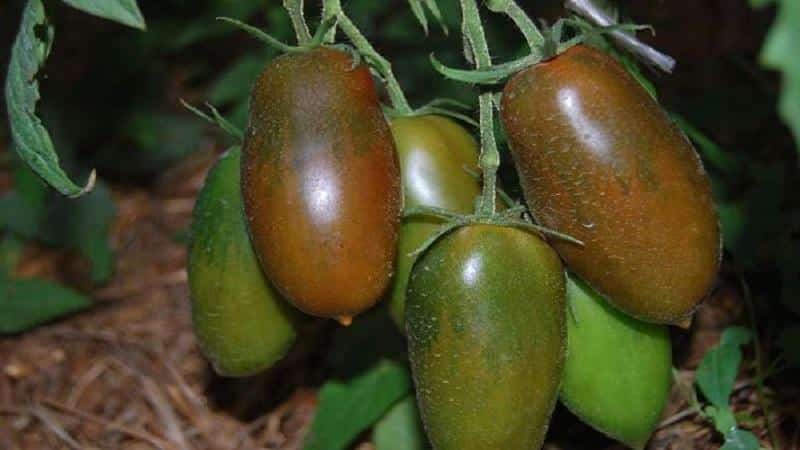
How to Grow Black Tomatoes
Given the variety of varieties, each of them requires an individual approach in matters of cultivation and care. However, general recommendations can be identified regardless of the specific variety.
It is recommended to plant tomatoes in early February.
When growing and caring for, you should limit the use of chemicals and mineral fertilizers and, if possible, replace them with organic ones.
Weekly, especially after rain, tomato bushes should be sprayed with a solution of Trichodermin, a biological preparation that protects plants from fungus. Kefir, kvass, garlic infusion or whey from sour milk are also suitable for this purpose.
Regularly tie up the bushes so that the fruits do not touch the soil. Dark tomatoes have very thin, delicate skin and juicy pulp, which easily become a target for various infections and attack by pests.
Bushes of dark varieties grow quite intensively, constantly forming new brushes and reaching a height of more than 1.5 m. Fertilizing is reduced to adding dry bird droppings to the soil (no more than two matchboxes per bush), ash or chalk (2-3 boxes per bush). bush).
Soil preparation
Tomato beds are placed in well-lit areas, sheltered from strong winds. It is better to choose a place where cucumbers, pumpkins or zucchini previously grew, as well as cabbage, onions or carrots. If potatoes, peppers or eggplants were grown on the site, then tomatoes can be planted on this soil only after 3-4 years.
The soil should be light and loose, well permeable to water and air. The structure of clay soil is further improved with the help of coarse sand (9 kg per 1 sq. m) and chopped straw (grass).
In the fall, after harvesting, the area for future tomato beds is cleared of weeds. During autumn plowing, organic fertilizers are added to the ground at the rate of 5-8 kg of humus or compost per 1 square meter. m plot.
Additionally, mineral fertilizer is scattered: per 1 sq. m use about 50 g of superphosphate (or 25 g of potassium salt). The dose of such fertilizers is adjusted depending on the fertility of the soil, in accordance with the instructions for the preparations.
Then the area is dug up to a depth of 25 cm. The found pest larvae are destroyed and the remaining roots are removed (plants often suffer from germ flies, which can cause tomato leaves to turn yellow). There is no need to level the soil - this way moisture is retained better.
Already in the spring you should fertilize the soil: 1 kg of bird droppings and wood ash, as well as 25 g of ammonium sulfate per 1 sq. m. m. After fertilizing, the area is dug up and leveled.
Then small furrows are made at intervals of about 1 m from each other. It is convenient to make beds about 80 cm wide, with sides about 5 cm high.
Seed preparation
First, you need to select viable seeds: conduct a visual inspection and set aside all damaged specimens, as well as those that have an uncharacteristic shade of the shell.
To confirm the viability of future tomatoes, you need to carry out the following procedure:
- Prepare a saline solution at the rate of 50 g of salt per 1 liter of water at room temperature.
- Pour tomato seeds into the container with the solution and stir with a wooden stick for two minutes.
- Drain all specimens that float to the surface.
- Wash the seeds that have settled to the bottom in clean water and dry them - they will be used for sowing.
Seed material must be disinfected in a solution of potassium permanganate, which will reduce the risk of infection of future tomato seedlings with fungal diseases.
Step-by-step instructions for sowing
Step 1. Place tomato seeds in a small saucer and select only sprouted ones.
Step 2. To plant seeds, you need ordinary tweezers, with the help of which the seed is moved from the saucer into the ground, one seed at a time.
Step 3. You can use any container or plastic cup as a planting container. Pour the moist soil mixture into it and make several shallow grooves using a screwdriver or other object.
Step 4. Place the seeds with tweezers. The approximate distance between them is 1.5-2 cm.
Step 5. Sprinkle with soil. This can be done with a spoon or your finger. Then lightly compact the soil.
Step 6. Spray the soil surface with a spray bottle.
Step 7 Cover the container with film or regular glass and leave it on a warm windowsill. After about 7-8 days, the first shoots should appear. After this, the glass must be removed and the seedlings must be allowed to develop fully, with additional lighting and watering.
Aftercare
All plants require care. To ensure that tomato seedlings grow evenly, you need to regularly rotate the seed container relative to the window. This procedure is performed to protect the stem from bending towards the light source.
The temperature should not be below 24°C. This indicator should be ensured until the first shoots appear, that is, approximately 7-10 days.If the temperature drops below the recommended level, seedlings may appear much later.
Before picking, you do not need to water the seedlings abundantly: watering should be moderate so that the soil does not dry out, but is not too wet. For irrigation, it is advisable to use warm water (temperature not lower than 24°C).
Planting and caring for seedlings in open ground
Requirements for planting black tomato seedlings on open ground the following:
- cotyledon leaves should not touch the soil;
- Before planting, seedlings must be treated with boric acid;
- It is better to plant in cloudy weather, otherwise the plant will burn;
- The ground should be watered with a solution of potassium permanganate and a hot solution of mullein.
Caring for planted seedlings is as follows:
- It is imperative to remove the stepsons, as they will slow down the process of fruit ripening.
- 20 days after planting, you need to do the first feeding of black tomatoes using nitrophoska.
- The second feeding is carried out immediately after the appearance of the second flower cluster; chicken droppings are used for fertilizer.
- The third fertilizing is done with mineral fertilizers after the appearance of the third flower cluster.
Prevention of diseases and pests
Fungal diseases include various types of rot. The most common of them are black, gray and white.
Methods of treating plants in this case are as follows:
- seedlings need to be sprayed with copper oxychloride;
- remove dead leaves;
- Fertilize the soil with Trichodermin a week before the intended planting.
Fighting viral diseases is difficult. The measures are preventive in nature. It is important to maintain optimal conditions for growing seedlings and maintain cleanliness.
Here are the necessary measures:
- to prevent late blight, 30 days after planting the crop should be treated with “Fitosporin”;
- plant tomatoes away from previous planting sites;
- destroy weeds;
- Thoroughly disinfect containers for planting and greenhouses.
To combat insects, crops should be planted next to the vegetable that repel aphids and other pests.
Review of popular varieties and reviews from summer residents
According to the method of cultivation, varieties of black tomatoes are divided into those that are grown in a greenhouse and those that grow well in open ground.
Varieties for open ground
To grow tomatoes that are more sensitive to low temperatures, you can use film cover in the spring. For planting in open ground in central Russia, varieties of black tomatoes are suitable, the description of which you will find below.
Black Prince
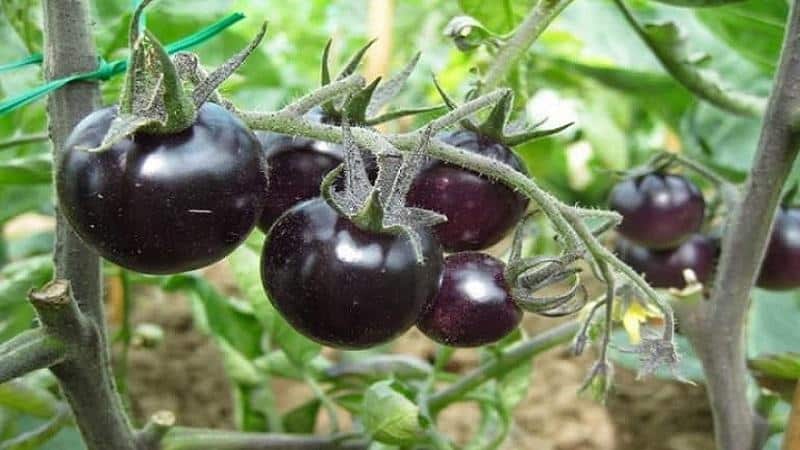
The crop is productive, of medium height, the bush is spreading, and therefore requires garter. The variety ripens quickly and is grown from seedlings. Seeds are sown at the end of February.
In mid-June, the first ovaries begin to form. The fruits have a dark red hue, their weight ranges from 150 to 450 g. Regular watering will ensure a good harvest. Due to its thin skin, the Black Prince variety does not tolerate transportation well. It is added to salads, sauces and juice.
According to reviews from summer residents, the germination rate of seeds is high, seedlings can be grown without much difficulty, tomatoes delight with good taste and a bountiful harvest.
Black Moor
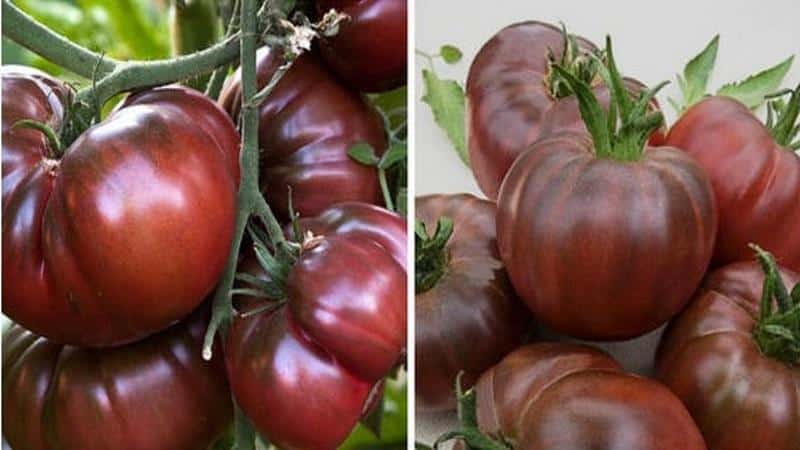
The variety is considered mid-season and determinate. The harvest can be harvested 115-125 days after emergence. The bushes reach up to a meter in height, with 7-10 fruits growing on one cluster, which weigh about 50 g. They have a dark red color, oval shape and dense skin.
The stepsons of this variety need to be pruned. Black Moor can be eaten fresh or canned.
Gardeners speak extremely positively about this variety, calling it fruit-bearing and “responsive” to fertilizing. They also note that tomatoes ripen well in boxes and have a rich taste both fresh and canned.
Black icicle
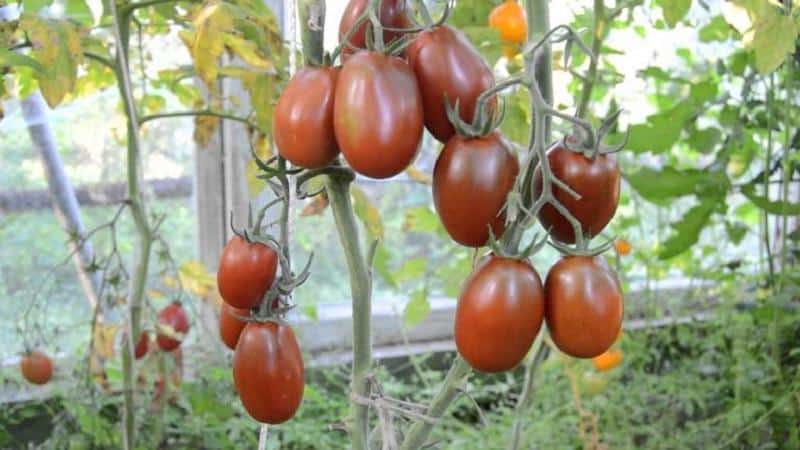
The variety belongs to the indeterminate mid-early species. The growing season of the plant lasts 90-110 days. The variety is quite productive. 6-9 fruits are formed on one brush. For growing, you should leave 3-4 stems. The tomato is adapted to adverse weather conditions and is resistant to diseases.
In reviews, gardeners admire the variety’s ability to actively set fruit. Those who have previously grown the Black Icicle tomato praise it for its sweet and delicate taste, as well as its versatility of use.
Varieties for greenhouses
Greenhouse seedlings are planted earlier, since the greenhouse protects the plant from frost and adverse weather conditions. Below are popular varieties of black tomatoes for growing in a greenhouse.
Black Crimea

The variety is mid-early and needs 70-80 days to ripen. The bushes grow up to 1.8 m. Black Crimea is intended only for growing in a greenhouse and is quite disease resistant.
The fruits are ribbed and flat-round in shape (see photo). Before final ripening, they are green-brown in color, and after that they turn black. The weight of one fruit is 500 g. Tomatoes are consumed fresh, added to salads, and juice prepared from them. The harvest does not last long.
Reviews about this variety are positive. Among the advantages they mention high yield and special taste.
De Barao black
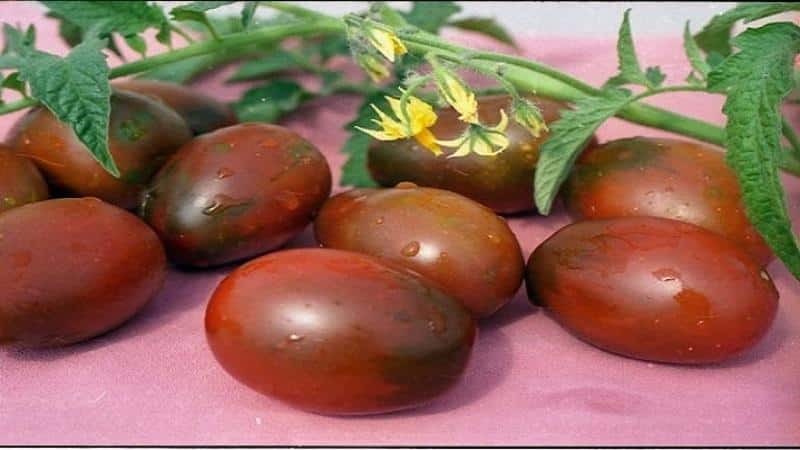
Variety De Barao black is indeterminate.It is resistant to various diseases and produces a good harvest. The tomato can grow up to 3 m in height, so it is designed for growing in tall greenhouses.
One bush produces from 6 to 7 kg of fruit. The fruits themselves weigh 40-70 g, have a round shape and a dark purple hue. This variety is stored for a long time and can easily be transported.
Tomatoes can be canned and consumed fresh. Summer residents say that this variety is ideal for harvesting for the winter.
Bison black
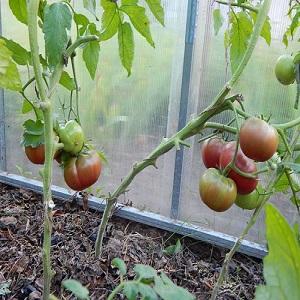
This variety can be classified as determinant and medium-late. The bushes reach a height of 1.5-1.8 m. They need to be tied up and the stepsons removed. The ribbed fruits have a flat-round shape and a dark purple color. Their weight is about 300 g.
Tomatoes have sweet and juicy flesh. They can be eaten fresh, added to salads and other dishes, but this variety is not suitable for canning. You can prepare juice and various sauces from these fruits.
Most farmers highlight the variety's good yield and pleasant taste. Among the disadvantages, cracking is mentioned.
Conclusion
Now you know what tomatoes are called black and what low-growing black tomatoes look like, and you also understand the varieties of black tomatoes. It is worth keeping in mind that tomato can bring not only benefits, but also harm to the human body.
To grow black tomatoes, you need to plant seedlings and plant them in open ground or a greenhouse. Throughout the entire period, the plant requires care and feeding.